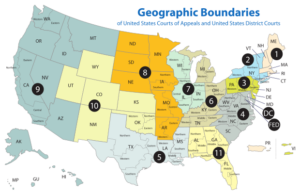The United States federal court system is a hierarchical structure consisting of three levels: the district courts, the courts of appeals, and the Supreme Court. District courts are trial-level courts who have jurisdiction over a wide range of federal cases, including criminal cases, civil cases involving federal law, and cases involving federal agencies. The courts of appeals are intermediate appellate courts, who hear appeals from the district courts and other federal agencies within their geographic jurisdiction. The Supreme Court is the highest court in the United States, and has the final say on all cases involving federal law and the United States Constitution.
 The federal court system was established by the Constitution, which gives Congress the power to create and regulate federal courts. Our first federal courts were created by the Judiciary Act of 1789, which only established district courts and the Supreme Court. The Act also created the Office of the Attorney General and provided for the appointment of federal judges by the President, with the advice and consent of the Senate.
The federal court system was established by the Constitution, which gives Congress the power to create and regulate federal courts. Our first federal courts were created by the Judiciary Act of 1789, which only established district courts and the Supreme Court. The Act also created the Office of the Attorney General and provided for the appointment of federal judges by the President, with the advice and consent of the Senate.
Over time, the federal court system has evolved and expanded to meet our country’s changing needs. The number of federal district courts and judges has increased while new courts of appeals have been established.
The District of Columbia Court of Appeals is the highest court of the District of Columbia. Established in 1970, it is equivalent to a state supreme court, except that its authority is derived from Congress rather than from the states’ inherent sovereignty. The court is located in the former District of Columbia City Hall building at Judiciary Square.
The D.C. Circuit is often considered the second most important court in the land, after the Supreme Court. It often has the responsibility for deciding cases having to do with the balance of powers of the branches of government and decisions made by government agencies affecting issues like health care, national security, environmental rules, and consumer protections and workplace safety. In fact, more U.S. Supreme Court justices have come from the D.C. Circuit than any other circuit court, including four current Justices: Chief Justice John Roberts, along with Associate Justices Clarence Thomas, Brett Kavanaugh and Ketanji Brown Jackson.
Consider some of the issues the D.C. Circuit has decided in recent years:
Environmental Protection
- In 2012, the court struck down the Environmental Protection Agency’s “Transport Rule” intended to control air pollution that crosses state lines.
Labor Disputes and Consumer Protections
- In 2013, the court invalidated the President’s three recess appointments to the National Labor Relations Board and an appointment to the Consumer Financial Protection Bureau, essentially making the NLRB non-functional and potentially nullifying over 200 labor and employment decisions.
Wall Street Reform
- In 2011, the court struck down the Securities and Exchange Commission’s proxy access rule, which would have made it easier for shareholders to propose their own nominees to the corporate board of directors.
Health Protections and Deceptive Advertising
- In 2012, the court struck down an FDA cigarette warning label law, citing the first amendment rights of cigarette companies.
National Security
- Since 2008, the circuit court has blatantly disregarded a U.S. Supreme Court ruling on the right to habeas corpus rights for Guantanamo Bay detainees and ignored the requirement that the circuit conduct a robust review of prisoners’ detainment.
https://www.americanprogress.org/article/why-the-d-c-circuit-matters/